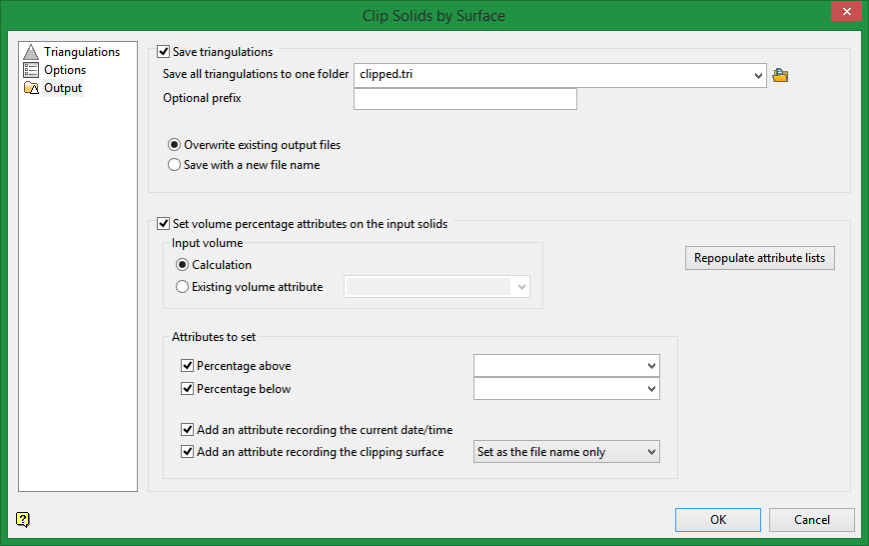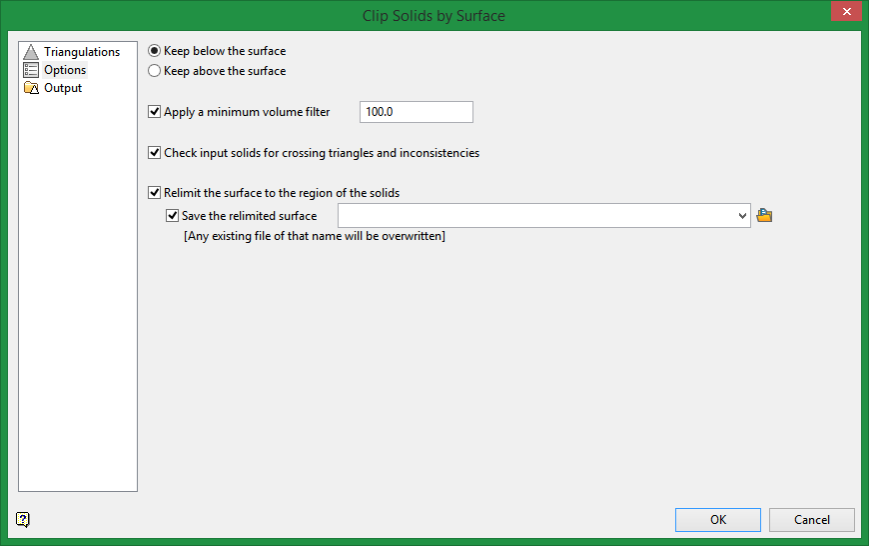Clip Solids
This is an option for clipping solids by a surface. It is designed to support clipping a large number of solids by a single surface. The solids which remain after the clipping can optionally be saved to a separate folder and/or have a prefix added to their name. Optionally, a volume filter can be applied which will delete any solids less than the given volume minimum value. If a solid is clipped into more than one piece, each piece must pass the minimum volume test or it will not be retained.

Surface name
Select the surface triangulation from the drop-down list or browse for it using the
 button.
button.
Select all triangulations in folder
Select this option if you wish to clip all of the triangulations stored in the same folder.
Select triangulations interactively
Select this option to choose triangulations individually. The triangulations do not need to be stored in the same folder. You may navigate to different folders and choose triangulations from each folder.
Keep below/above the surface
Select which clipped triangulations you want to keep, those above the surface triangulation or those below it.
Apply a minimum volume filter
You can apply a volume filter to avoid capturing triangulations that may be too small. These would include remnants that amount to slivers or other artefacts that are left over from the clipping process.
Check input solids for crossing triangles and inconsistencies
Select this option to perform a consistency check on the solid(s).
Relimit the surface to the region of the solids
When you have a surface covering a much larger region than the solids, the clipping process can be slow. Selecting this option will internally relimit the surface prior to clipping, without affecting the original surface triangulation.
Save the relimited surface
If you wish to save the relimited surface, select a location from the drop-down list, or browse for one using the
![]() icon.
icon.

Save triangulations
Select an output folder for the clipped triangulations. You may keep the default folder created automatically or enter a name of your own with the .tri file extension.
Optional prefix
Enter an optional prefix. This can be a data code, mining phase, etc.
Overwrite existing output files
Select this option to overwrite existing file names that have the same names.
Save with a new file name
Select this option to append a numeric suffix to the file name to form a unique name.
Set volume percentage attributes on the input solids
Select this option to set a volume percentage attribute to the input solid, and then select either Calculation or Existing volume as the method to determine the volume.
Calculation
The calculated volume of the input solid is used as the volume for the percentage calculation.
Existing volume attribute
The selected attribute of the input solid is used as the volume for the percentage calculation.
Repopulate attribute lists (button)
Build a list of attributes from the input solids.
Attributes to set
Percentage above
Add an attribute calculated as the volume above the surface as a percentage of the original volume.
Percentage below
Add an attribute calculated as the volume below the surface as a percentage of the original volume.
Add an attribute recording the current date/time
For each percentage attribute set, a matching attribute is added with the current timestamp.
Add an attribute recording the clipping surface
For each percentage attribute set, a matching attribute is added for the clipping surface file name. This name can be set as the file name component only, or the full path.


